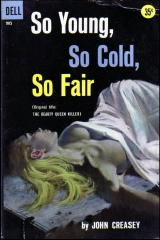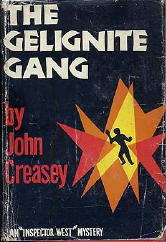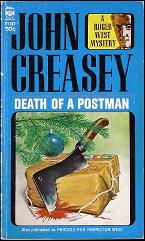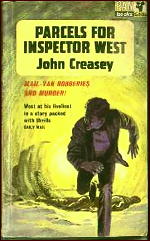Tue 30 Jun 2009
by Marvin Lachman
I suspect that detectives like Henry Tibbett [whose mystery case Falling Star, by Patricia Moyes, was reviewed here several days ago] were a reaction to the eccentric sleuths of an earlier era, e.g., Holmes, Wolfe, and Poirot.

Mystery writer John Creasey fathered a small army of detectives, all of whom had “smarts” and physical prowess, though none were especially colorful. Understandably, but perhaps unfairly, Creasey’s name has often made mystery readers smile. The most prolific mystery writer, he started by writing some dreadful books in his early days.
Nor were all of them mysteries, since he wrote in all genres. (One of his early “Tex Reilly” westerns is reputed to contain the deathless line about coyotes flying in the sky.)
Creasey was best known for his Commander George Gideon books, written under the J.J. Marric pseudonym, but G.G.’s roots were clearly in his older literary brother, Inspector Roger “Handsome” West, who appeared in forty-three novels and at least one short story.

West started off rather inconspicuously in 1942, depending on a socialite friend for much of his detection and legwork. However, as the series progressed, Creasey’s writing and West, as a hero, improved.
Happily, Harper’s Perennial Library has recently reprinted eight of the Roger West series, and their selection is excellent, as witnessed by the following examples.
Serial killers are everywhere today. (I’m sure I pass them on the streets as I walk from the train to work.) The Beauty Queen Killer (1954) is a good early example, with some exciting scenes, marred only by difficult to accept motivation.
The Gelignite Gang (1955) dates from the same year as the first Marric novel, and it also gives a good picture of London from a policeman’s viewpoint.

Here, the police are faced with a series of jewelry robberies, with the titular form of dynamite the common factor. When murder occurs during robbery in the city’s largest department store, West is called in to solve a mystery that has more surprises than most.
In Death of a Postman (1956) Creasey accomplishes what relatively few mystery writers do: he makes us care about the victim. A postal worker, who leaves behind a wife and five children, has been murdered during the Christmas rush. As we rapidly turn the pages of one of Creasey’s best narratives, we become involved and want West to track down a particularly heinous killer.
Bibliographic details:
The Beauty Queen Killer. Harper & Brothers, US, hardcover, 1956. First published in the UK as A Beauty for Inspector West, Hodder & Stoughton, hc, 1954. US paperback editions include: Dell 985, 1957, as So Young, So Cold, So Fair. Berkley F1095, 1965; Lancer 74757, 1971; and Perennial, 1987.
The Gelignite Gang. Harper & Brothers, US, hardcover, 1956. First published in the UK as Inspector West Makes Haste, Hodder & Stoughton, 1955. US paperback editions include: Bantam 1884, 1959; Berkley F1176, 1966, as Night of the Watchman; Lancer, 1971, as Murder Makes Haste; and Perennial, 1987.
Death of a Postman. Harper & Brothers, US, hardcover, 1957. First published in the UK as Parcels for Inspector West, Hodder & Stoughton, 1956. US paperback editions include: Bantam 1883, 1956; Berkley F1167, 1965; and Perennial, 1987.

June 30th, 2009 at 10:50 pm
I’m actually a big Creasey fan, and always liked the Roger West books, and these are some of the best in the series, though I prefer So Young So Cold So Fair (from St.James Infirmary)to The Beauty Queen Killer or A Beauty for Inspector West as a title.
Creasey is still highly collectible and has a legion of fans. Over the years he developed into a good writer, and unlike some so called better writers he at least was never dull. The West books got pretty good reviews later too, especially The Theft of the Magna Carta, Murder on the Line, and the above Death of a Postman.
An interesting note about The Gelignite Gang, it was the name of a real gang in England that played havoc as jewel robbers until the Met, in the person of the Yard’s famed Robert Fabian, brought them and the mastermind of the gang down.
That wasn’t the end of the story though. The head of the Gelignite Gang was Eddie Chapman, a gentleman cracksman in the almost fictional mode. He was sent to prison in the Channel Islands, and there when the German’s occupied them. He escaped execution by volunteering to work as a German agent, was eventually parachuted back into England, and promptly turned himself in. He became part of Sir John Masterman’s Double Cross system and passed on phony information to the Nazi’s for the rest of the war, eventually being awarded the Iron Cross, and at one point even going back to Germany briefly. His handler during his wartime exploits was Robert Fabian.
After the war Eddie was pardoned and opened a hotel. Eventually he wrote a book about his experience called Triple Cross that became a movie with Christopher Plummer as Eddie. Eddie and Fabian became friends and Fabian appeared on a television special about Eddie at one point.
But I’m sure Creasey was just capitalizing on the headlines about the real life gang, as Eddie’s story was still a secret in 1955.
July 1st, 2009 at 1:23 am
Rereading the review it strikes me Creasey may have been thinking of Fabian of the Yard when he wrote The Gelignite Gang. Robert Fabian gained his first fame in the 1920’s when he was a young detective. He was called in to a terrorist bomb planted in an East End department store, and in those days when the bomb squad was military, he defused it by himself with only a penknife.
He was credited with saving hundreds of lives and awarded the George Cross, the highest civilian honor for courage. The people of the East End, crooks included (shades of Creasey’s the Toff) gave him a medal too, which he always treasured.
Fabian, who is about as close as real life comes to the fictional Yard Man we all know and love, was likely one of the inspirations for Roger West originally.
Fabian’s career is touched on in many nonfiction crime books as he was involved in some of the major crimes of his era from the Rillington Place murders to the Yorkshire Ripper. His own book is called Fabian of the Yard.
July 1st, 2009 at 9:51 am
That’s a lot of interesting info on Robert Fabian, David. Thanks!
As for Creasey, I think I like his older and somewhat cruder books better than his later ones. His later books all felt mass-produced to me, a fact not necessarily related to how many books he was writing a year, since he always was prolific.
I also prefer his Toff-like heroes over the Gideon and West characters, though their books were always OK. You always know what you were going to get in them, though, while with the Toff and Creasey’s earlier books, there was an edge of adventure to them.
I never did care for his Dr. Palfrey books, though, and I’d be hard-pressed to come up with a Department Z thriller I’d rave about. (I suspect that many of the latter were ‘modernized’ from their 1930s origins, though, when they were reprinted by Popular Library here in the US in the 1970s.)
— Steve
July 1st, 2009 at 4:59 pm
Steve
Like you I prefer the Toff and the Baron, and even Patrick Dawlish to West and Gideon, but still give the coppers their points.
I love the Palfrey books, but admit they are a special case and the most political of Creasey’s works (many don’t know Creasey was actively involved in politics and even started his own party). The sheer audacity of the books always amuses me. In at least one book at the end the only life left on the planet is above the tree level high in the mountains, but at the start of the next book everything is back to normal. Resilient race aren’t we?
I’m not a big fan of the Dept. Z Gordon Craigie books, I did enjoy the Bruce Murdoch (the Liberator) books of the wartime era, especially I Am the Withered Man in which the book is narrated by Murdoch’s arch nemesis the Gestapo agent known as the Withered Man (a tip of the hat to Valentine Williams Clubfoot no doubt). Not many writers would try that gimmick.
Creasey fans should look up W. Vivian Butler’s The Durable Desperados about the British gentlemen adventurers of the era. He writes about all of the famous characters, but he is especially good in regard to Creasey — and should be as he briefly continued the Toff and Gideon series after Creasey’s death.
July 2nd, 2009 at 11:30 pm
Steve,
Just a brief e-mail to point out to you (and David Vineyard) that I presume it is Robert Fabian of the Yard (not Falcon) that David is thinking of as the inspiration for Inspector West (though I would say that Fabian inspired George Gideon).
Fabian joined Scotland Yard in 1921 as a constable, worked his way up to the Vice Squad (1926) and finally, to Superintendent of the CID. He played a prominent roll in numerous high profile cases including the murder of Alex De Antiquis (1947) and the “Black Butterfly” murder (1939). He retired 1949. #
# taken from the Historical Dictionary of Law Enforcement
My copy of Fabian of the Yard not to hand at the moment but I am sure he had no involvement investigating the Murders at Rillington Place nor Eddie Chapman’s work as a double agent.
Inspector West also worked his way up to Superintendent
Regards,
Jamie
July 2nd, 2009 at 11:34 pm
Jamie, you’re right of course, Fabian, not Falcon, Can’t believe I wrote Falcon in my original comments, the mind must be going.
The references to Eddie Chapman are 100% accurate, and Fabian did appear with Eddie on British tv when Eddie was accused of making up his story of being a British spy. He was brought in to identify Chapman when Eddie turned himself in after being parachuted into England.
None of this would be mentioned in his own book as the Chapman affair did not break until the late fifties early sixties when Chapman wrote his book which was promptly censored.
As a result of the Chapman book Sir John Masterman wrote his own account of the running of double agents The Double Cross System. Most of this was still highly secret when Fabian wrote his book.
Hell, Ian Fleming was nearly prosecuted for even mentioning a code machine in From Russia With Love that might have given away the whole Ultra business.
I don’t know that Fabian led the investigation on the Gelignite Gang, but he did go on British tv to back Chapman’s story — I’ve seen it, it aired on American television as a segment on one of the magazine shows.
I recall at the time being struck how much Fabian looked like what you would expect.
You may be right about the John Christie murders, but I do think a retired Fabian may have consulted on the Yorkshire Ripper, but not certain.
Still, the Chapman thing is accurate. I would agree Fabian was the direct influence on Gideon, but I suspect he was also a minor influence on West.
And the book The Gelignite Gang is at least inspired by Eddie whose operation was known as the Gelignite Gang for the method they used to blow safes.
If Fabian doesn’t mention it, it is possible he was just avoiding the whole Official Secrets Act business. But he came forward and spoke up on television for Chapman when Eddie was in trouble over the book.
David
December 11th, 2010 at 1:25 am
One correction to David’s comment above. Bob Fabian did not get the George Cross for defusing that IRA bomb. He got the King’s Police Medal, the highest award for law enforcement in the British Commonwealth.
Fabian was the subject of a DRAGNET-like TV series called FABIAN OF THE YARD. Just as DRAGNET was the first filmed TV drama series on American TV, FABIAN was the first filmed TV drama on British TV. It starred Bruce Seton as Fabian. In an epilog at the end of every episode, Seton, as Fabian, seated at a desk, would morph into the real-life Bob Fabian who would explain what happend to the perpetrators of that episode’s crime.
The pilot for the series, “Bombs in Picadilly,” fictionalized the IRA bombing incident, and Fabian’s decommissioning of the bomb with a pen knife, though the terrorists were now vaguely Bolshevik peaceniks instead of Irish dynamiters.
The popularity of DRAGNET and FABIAN were part of what inspired Creasey to create Gideon, and to tone down the melodrama in the West series to make them more realistic in tone.